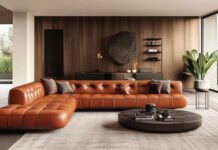Selecting the right hardwood flooring can transform your home, adding elegance, warmth, and durability. Whether you are renovating a single room or the entire house, understanding key factors will ensure you make the best decision. Consider aspects such as wood species, durability, and finish to find a floor that complements your interior. A professional flooring company can provide expert guidance and a wide range of high-quality options to match your style and budget. By choosing wisely, you can achieve a timeless, sophisticated look that enhances your home’s aesthetic appeal and functionality for years to come.
Why Hardwood Flooring Is Worth Buying
Hardwood flooring offers numerous benefits, making it a top choice for homeowners seeking elegance and durability. Its timeless appeal enhances property value, ensuring a solid long-term investment. Unlike carpets, hardwood floors are easy to clean, hypoallergenic, and resistant to dust accumulation, making them ideal for allergy sufferers. They provide impressive durability, lasting for decades with proper care. Hardwood flooring also complements various interior styles, from modern minimalism to rustic charm, offering unmatched versatility in design. Additionally, eco-friendly options are available, ensuring sustainability. With regular maintenance and refinishing, these floors retain their beauty, making them a practical, stylish, and long-lasting flooring solution.
Factors to Consider When Choosing Hardwood Floors
When selecting hardwood flooring, consider durability, wood species, grain patterns, and finish. Each factor impacts longevity and aesthetics. High-traffic areas need harder woods like oak or maple, while exotic species add unique character. A trusted hardwood flooring store provides expert advice, helping you choose the ideal material to match your style, needs, and budget.
Durability & Hardness Rating
Hardwood durability is determined by the Janka hardness rating, which measures resistance to wear, dents, and impacts. Oak, maple, and hickory score high on this scale, making them ideal for high-traffic areas like living rooms and hallways. Softer woods, such as cherry or walnut, offer visual appeal but are better suited for low-traffic spaces like bedrooms. Choosing the right hardness rating ensures longevity while maintaining the floor’s integrity over time.
Wood Species & Grain Patterns
Different wood species offer unique grain patterns and colors. Oak and maple have uniform, consistent grains, while hickory features dramatic variations that add character. Exotic woods like teak or mahogany provide a rich, luxurious aesthetic, ideal for elegant interiors. The right grain pattern enhances visual appeal, influences ambiance, and adds texture to the overall flooring design, creating a distinctive and stylish atmosphere in any room.
Color, Stain, and Finish Options
Color plays a significant role in interior design. Lighter woods, such as maple, create an open, airy feel, making spaces appear larger. Darker stains, like walnut, bring warmth and sophistication, adding a rich depth to any room. Matte and satin finishes provide a natural look, while glossy finishes offer a polished, refined appearance. A wide range of stain options allows homeowners to customize their floors to match various decor preferences and styles.
Best Hardwood Flooring Materials for Different Rooms
Each room has unique flooring needs based on foot traffic and moisture exposure. High-traffic areas require durable hardwood, while moisture-prone spaces need water-resistant options. The right hardwood choice balances functionality, durability, and style, ensuring longevity and aesthetic appeal. Consulting experts can help select the best materials to enhance both practicality and design.
Living Room/Family Room: Oak, Maple or Hickory
Living rooms see heavy use, so selecting a durable hardwood is crucial. Oak, maple, and hickory stand out for their strength, with excellent resistance to dents and wear. These woods maintain their appearance over time while adding warmth to the space. Their grain patterns vary from subtle to bold, allowing customization to match diverse interior styles and personal preferences. Choosing the right finish enhances durability and complements the room’s overall aesthetic.
Kitchen: Hard Maple, Cherry, or Oak
The kitchen demands a hardwood that resists spills, foot traffic, and frequent cleaning. Hard maple, cherry, and oak are excellent choices due to their durability, scratch resistance, and aesthetic appeal. These woods maintain their strength over time while adding warmth to the space. Applying a high-quality protective finish enhances their resistance to moisture, stains, and daily wear, ensuring long-lasting beauty and functionality for a busy kitchen environment.
Dining Room: Cherry or Walnut
For a sophisticated dining area, cherry and walnut are excellent choices. Their deep, rich tones create an elegant and inviting atmosphere, enhancing the room’s ambiance. These woods have smooth grains that add a touch of refinement and luxury. Cherry darkens gracefully over time, while walnut’s rich hues complement various dining furniture styles. Both options offer durability and timeless beauty, making them perfect for both traditional and contemporary dining room designs.
Home Office: Maple or Oak
Home offices benefit from the durability and aesthetic appeal of maple and oak. These species create a professional yet inviting atmosphere, enhancing productivity. Maple’s smooth grain provides a clean, modern look, while oak adds warmth and character. Both options withstand heavy furniture and foot traffic, ensuring longevity. Their natural tones complement various office decor styles, making them ideal choices for a functional and stylish workspace.
Stairs: Oak, Maple, or Cherry
Stairs experience heavy usage and require sturdy materials to withstand daily wear. Oak, maple, and cherry offer excellent durability, minimizing dents and scratches over time. These hardwoods provide a sleek and polished look, enhancing the home’s overall aesthetic. Their strength ensures safety and longevity, while their rich grain patterns add character. Proper finishing and maintenance help preserve their beauty, making them an ideal choice for a lasting and elegant staircase.
Hallways and Entryways: Hickory, Oak, or Walnut
High-traffic areas like hallways and entryways require durable hardwoods that can withstand constant foot traffic and potential impacts. Hickory, oak, and walnut are excellent choices due to their superior resistance to scratches, dents, and wear. These hardwoods maintain their appearance despite frequent use, adding warmth and charm to entry spaces. Their rich grain patterns and natural tones enhance the overall aesthetic, making them a practical and stylish option for any home.
Bathrooms: Engineered Hardwood or Teak
Traditional hardwood may not endure bathroom moisture, but engineered hardwood or teak offers an excellent alternative. These materials resist humidity, minimizing the risk of warping or swelling. Engineered hardwood features a stable core that withstands moisture fluctuations, while teak naturally repels water due to its high oil content. Applying a waterproof sealant further enhances protection, ensuring these flooring choices provide durability, longevity, and the classic beauty of hardwood in a moisture-prone environment.
Solid vs. Engineered Hardwood: Which One to Choose?
Choosing between solid and engineered hardwood depends on durability, moisture resistance, and long-term maintenance. Solid hardwood is a single, thick piece of wood that can be refinished multiple times, making it highly durable. However, it expands and contracts with humidity, which can lead to warping in moisture-prone areas.
Engineered hardwood, composed of multiple layers, is more resistant to humidity fluctuations. Its top layer is real wood, providing a natural appearance, while the core layers offer structural stability. This makes engineered hardwood ideal for basements, kitchens, and bathrooms.
Solid hardwood works best in dry, high-traffic areas where long-term refinishing is a priority. Meanwhile, engineered hardwood suits spaces where moisture levels vary. While engineered wood cannot be refinished as many times as solid hardwood, high-quality options still last for decades.
Ultimately, the choice depends on your budget, location, and lifestyle needs. Solid hardwood offers timeless beauty and refinishing flexibility, while engineered wood provides stability in humid conditions. Consulting flooring professionals ensures you select the best option for your home’s needs.
Conclusion & Final Recommendations
Hardwood flooring remains a top choice for homeowners due to its durability, elegance, and long-term value. Investing in high-quality hardwood enhances your home’s aesthetic appeal while providing a durable and timeless flooring solution. Whether choosing solid or engineered hardwood, consider factors like wood species, grain, stain, and finish to match your needs. Different rooms require different hardwood types to balance beauty, functionality, and durability. Hardwood floors complement various interior styles, from traditional to modern, making them a versatile choice. With proper maintenance, these floors can last for decades, retaining their charm and strength. Regular cleaning and refinishing preserve their appearance, ensuring long-term value.
Additionally, hardwood flooring is an eco-friendly choice when sourced responsibly, adding to its appeal. Consulting flooring professionals help you select the best option based on your lifestyle, budget, and design preferences. By making an informed decision, you ensure that your hardwood flooring remains a valuable and lasting investment.






